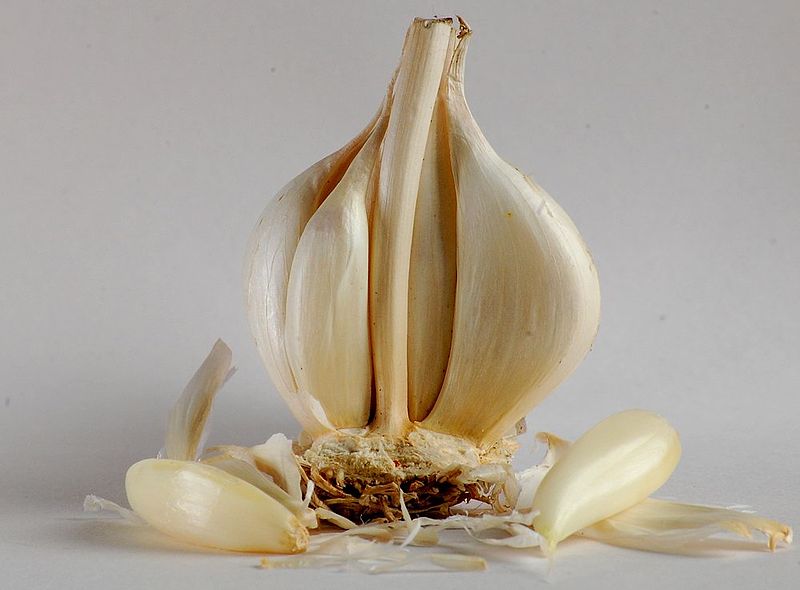Garlic is renowned for its broad range of culinary and medicinal uses, from reportedly imparting strength to laborers who built the pyramids to more modern studies about its antibacterial and beneficial circulatory effects.
Where to Grow Garlic
Garlic is an annual or perennial cool-season crop and is hardy to frost and light freezes. Plant cloves in a sunny location in deep, rich, well-drained soil.
Soil for Growing Garlic
Garlic prefers full sun, moist, well-drained soil, and is quite tolerant of various soil types and textures. The preferred texture appears to be a sandy loam that is easily crumbled in hand. It does best when the pH is in the 6.2 to 6.8 range, but it can tolerate a wide range of pH and still produce well. The soil should drain easily, as standing water could cause the bulbs to rot in the ground. As with other root crops, proper preparation of the soil is crucial. The top 6-12 inches should be broken up well, so the roots are free to grow. This is also a good time to mix in some organic matter or manure to improve the soil.
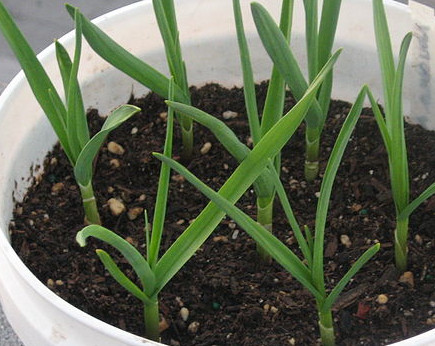
Planting Garlic
When –
Cloves may be planted in either fall or spring, but fall plantings will yield larger bulbs the next summer than spring plantings harvested in fall. Garlic should be planted 4-6 weeks before the last frost date. The plants benefit from having some warm weather to allow good root formation. It is a good sign to see the green shoots come up in late autumn; they can tolerate frigid weather.
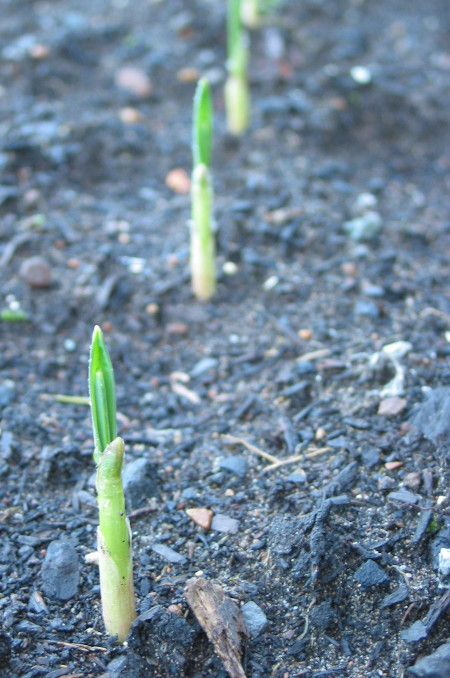
| Temperature | |
| Germination | 60 - 80 F |
| For Growth | Cool |
| Soil and Water | |
| Fertilizer | Light Feeder |
| pH | 4.5 - 8.3 |
| Water | Low: For perennial bulbs, withhold all water during summer |
| Measurements | |
| Planting Depth | 1" - 2" |
| Root Depth | 2 - 24" |
| Height | 1 - 3' |
| Width | 6 - 10" |
| Space between plants | |
| In beds | 3" |
| in rows | 4 - 6" |
| space between rows | 12 - 15" |
| Companions | |
| Companions | Beet, Brassicas, Celery, Chamomile, Fruit Trees, Lettuce, Raspberry, Rose, Savory, Tomato |
| Incompatibles | Beans, Peas |
| Harvest | |
| Green garlic shoots, a gourmet treat in many locales, can be cut from the bulbs going to flower and used like scallions. Garlic bulbs are ready to harvest when the tops turn brown and die back. Do not knock the tops down to hasten the harvest; some research indicates this practice will shorten storage life. Withhold water and in a few days, carefully dig to lift the plants up. Be careful not to bruise the bulbs so they won't get moldy or attract insects in storage. | |
How –
Although it can be started from seed, it’s easiest to grow from individual cloves. The bulb should not be “cracked” more than 48 hours before planting. Splitting the wrapper and separating the individual cloves before this causes them to dry out and lose viability. Bigger cloves tend to produce bigger bulbs, so save the largest cloves for your garden if you prefer large bulbs. The smaller ones are reported to taste better anyway.
The bulbs’ tips should be placed 2″ below the soil surface (3-4″ for elephant garlic), pointy side up. They can be spaced in rows 4-6″ apart, with rows at least 12-15″ apart.
| Storage Requirements | |
|---|---|
| Cure bulbs in the sun for up to 2 weeks to harden the skins and dry. To braid, keep the tops on. Otherwise, clip off the dried leaves and root bunches. Store in paper bags, net bags, or nylon stockings, tying a knot between each bulb in the stocking. | |
| Method | Taste |
| Fresh | Excellent; lasts 6-7 months |
| Dried | Good as powder, slices, or granules |
Cultivating Garlic
Remove any flower buds as soon as they develop. Garlic likes the soil to be moist but not soggy. Regular watering in the fall is essential for proper germination. If dry, watering in the winter may also be required. Stop watering once the bulbs are finishing development to allow bulbs to dry out before harvesting (about 4 weeks before harvest). Like onions, garlic does not compete well with weeds, so it is important to keep the weeds under control with mulch and constant weeding as required.
Garlic does appreciate fertilizer, and a general 10-10-10 works well, at a rate of 3 pounds per hundred square feet. This should be worked into the top few inches of the soil. One of the real keys to success is mulching. Mulching is essential to increase the plants’ tolerance to frigid weather; the colder it is, the more mulch is required. The mulch should be applied immediately after planting, perhaps after a good soaking. The garlic shoots should have no problem coming through several inches of mulch; it should help keep the weeds down as well. If the mulch is extra thick, you could remove some of it in the springtime, leaving enough to control the weeds.
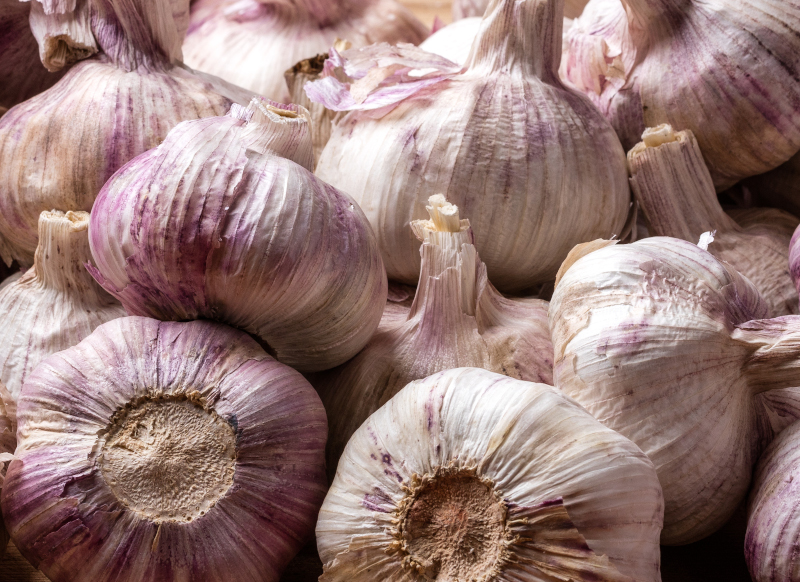
Harvesting Garlic
Garlic bulbs mature in an average of 6 to 10 months.
Many people wait too long to harvest garlic bulbs. Once the lower 1/3 – 1/2 of the leaves have turned brown, and there are still mostly green leaves near the top of the plant, it is ready to harvest. Observe your plants carefully to ensure you pick them in their prime. Generally speaking, they should be dug up. Pulling on the stalks will break the top off and leave the bulb submerged under the soil. Use a pitchfork to loosen the soil around the plant, which allows the entire plant to be lifted out of the ground freely.
Garlic will need to be cured before long term storage. A properly cured garlic clove can be safely stored for up to 6 months. The entire plant will need to be dried in a well-ventilated location. The simplest way is to tie up several plants together in a bunch and hang them for a few weeks. Do not wash the bulbs or allow them to be exposed to any water. Throw away moldy bulbs as soon as they are noticed. Once curing is complete, cut the tops off about 1″ above the roots. Garlic is stored best between 50-70F, and a relative humidity of ~ 50% seems to be ideal. They can be stored in an onion-type mesh, or burlap bag hung in a well-ventilated room. Do not store at high humidity or in the refrigerator. They will sprout in a hurry. The soft neck varieties tend to have a longer shelf life.
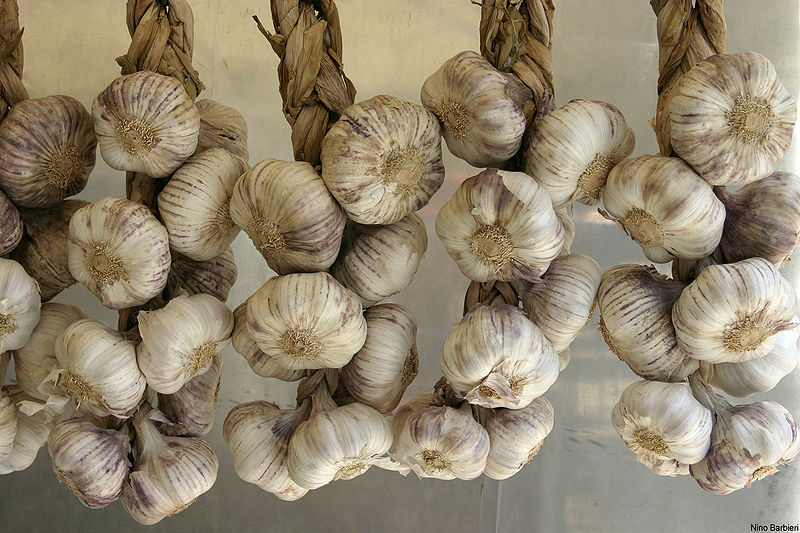
Garlic Pests
None of major concern
Garlic Disease
None of major concern
